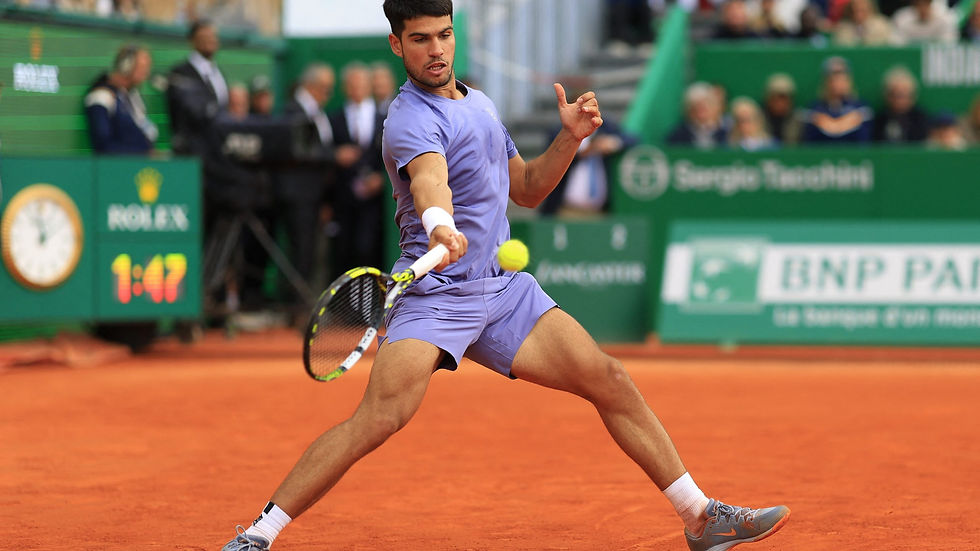Elevate Your Game with Effective Footwork: Lessons from Alcaraz, Federer, and Sinner
- Desmond Woo
- Jun 11
- 4 min read
Updated: Jul 17

Have you ever felt a step slow or off-balance during your tennis matches? You're not alone. Perfecting your strokes is essential, but the foundation of every great shot is excellent footwork. As Roger Federer famously said, "My game is a lot about footwork. If I move well, I play well."
In this detailed analysis, we'll explore the footwork of Carlos Alcaraz, Roger Federer, and Jannik Sinner—three masters of tennis movement. We'll also provide practical tips to enhance your performance on the court.
Why Footwork Matters
Footwork is crucial because it positions you to hit each shot comfortably and powerfully. Good footwork ensures balance, conserves energy, and aids quick recovery.
Central to tennis footwork is the split step—a small hop executed right as your opponent strikes the ball. This technique helps you react quickly in any direction. Without solid footwork, even the strongest swings can become ineffective.

Understanding the Key Elements of Great Footwork
Before diving into our players’ examples, let's understand some fundamental aspects of tennis footwork:
1. Split Step
The split step primes your body to move swiftly. Timing is critical—land just as your opponent hits the ball.
2. Stance
Common stances include open, semi-open, and neutral. Each has distinct advantages, and great players seamlessly switch between them based on the situation.
3. Adjustment Steps
Fine-tune your position with small steps to ensure optimal balance and striking position.
4. Recovery Steps
Quick recovery using crossover steps enables you to reposition efficiently after each stroke.
5. Balance and Low Center of Gravity
Staying low and balanced helps with explosive directional changes and stable shot execution.
Carlos Alcaraz: Explosive & Dynamic Footwork
Carlos Alcaraz is renowned for his explosive movement and relentless energy. Examining footage of Alcaraz rallying, several standout traits emerge:
Perfectly Timed Split Step: Alcaraz initiates his split step exactly as the ball leaves his opponent's racket, enabling rapid lateral movement.
Rapid Adjustment Steps: These precise small steps ensure he's always perfectly positioned.
Dominant Open Stance Forehand: Frequently uses an open stance to generate powerful shots without compromising his balance.
Swift Recovery: Employs crossover steps efficiently, ensuring he's back in position swiftly after each shot.
Alcaraz's agility comes from constant activity on his toes, maintaining an athletic, low stance. Beginners can benefit from adopting his intensity and readiness.

Roger Federer: Graceful Efficiency
Federer’s legendary footwork is synonymous with elegance and efficiency. Key features of his movement include:
Economical Movement: Minimal, purposeful steps. Federer anticipates shots early, conserving energy and maintaining composure.
Precise Split Step Timing: Executes split steps exactly at the opponent's moment of impact.
Impeccable Balance: Consistently balanced, allowing controlled and powerful strokes.
Versatile Stances: Easily transitions between neutral and open stances, adapting to each situation.
Smooth Recovery Steps: Uses elegant crossover movements to swiftly regain optimal court positioning.
Federer's advantage lies in anticipation and energy-efficient movement. Beginners should strive for simplicity, purpose, and anticipation in their footwork.

Jannik Sinner: Balanced & Precise
Jannik Sinner exemplifies stable, controlled footwork. His style might not be flashy, but it is incredibly effective:
Stable Wide Base: Maintains a broad stance for outstanding stability, even when fully stretched.
Controlled Movements: Uses deliberate strides coupled with quick adjustments for precise positioning.
Low Center of Gravity: Stays consistently low, enhancing balance and facilitating rapid directional changes.
Reliable Split Steps: Consistent and precisely timed, ensuring readiness for every shot.
Sinner shows beginners that controlled, intentional movement can be just as effective as raw athleticism.
Practical Footwork Tips to Enhance Your Game
Applying these professional insights practically can drastically improve your game:
1. Prioritize the Split Step
Consistently perform split steps to enhance your responsiveness.
2. Remain on Your Toes
Maintain activity and avoid flat-footedness to swiftly react to incoming shots.
3. Master Adjustment Steps
Practice quick, small steps to optimize your hitting position.
4. Efficient Recovery
Utilize crossover steps to rapidly reposition after each stroke.
5. Adopt a Stable Stance
Maintain a low, wide stance for balance and agility.
6. Develop Anticipation
Observe your opponent’s body and racket cues to anticipate shot direction early.
7. Regular Drills
Regularly include agility ladders, jump rope, and shadow tennis to enhance footwork skills.

Effective Footwork Drills
Incorporating structured drills into your practice routine can significantly boost your footwork proficiency:
Jump Rope: Improves timing, agility, and foot speed.
Agility Ladder: Enhances quickness, coordination, and adjustment steps.
Shadow Tennis: Practicing strokes and footwork patterns without a ball builds muscle memory.
Cone Drills: Simulates realistic match movements, enhancing directional agility and recovery.
Building Better Footwork Habits
Creating lasting improvement involves gradual, consistent changes:
Incremental Practice: Start with one or two aspects, such as split steps and crossover recovery, and gradually incorporate others.
Consistent Feedback: Record your practice sessions and matches to review your movements and make necessary adjustments.
Conditioning: Strengthen your legs and core through off-court training, enhancing your on-court agility and endurance.
Final Thoughts
Improving footwork is fundamental to tennis progression. By embracing strategies demonstrated by Alcaraz, Federer, and Sinner, you can dramatically elevate your game. Remember, your hands execute strokes, but your feet create opportunities. Focus on footwork consistently, and watch your overall tennis skills soar.
Additionally, for those looking to take their game a step further, consider enhancing your training with specific resources on footwork techniques.




Commentaires